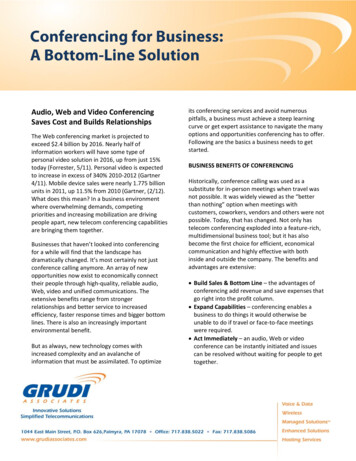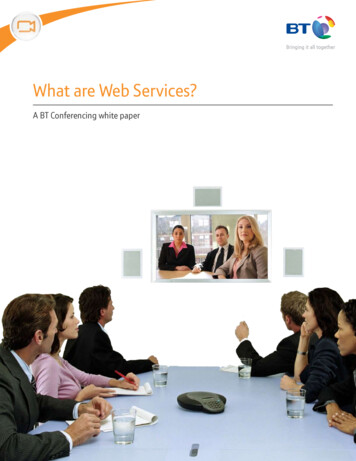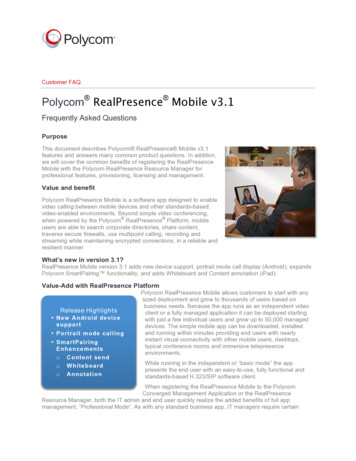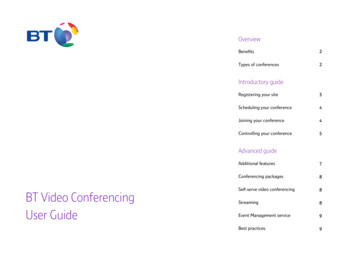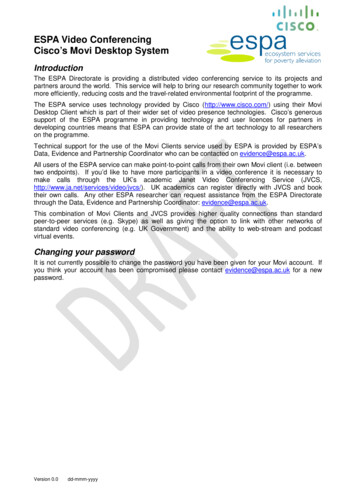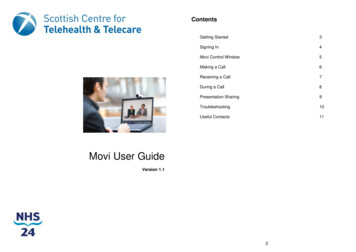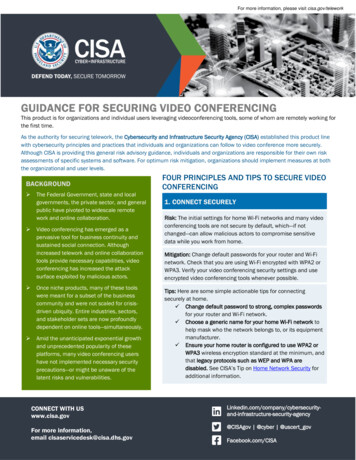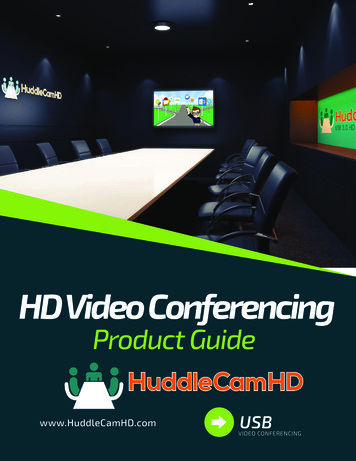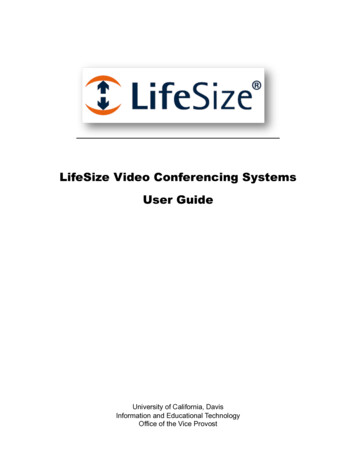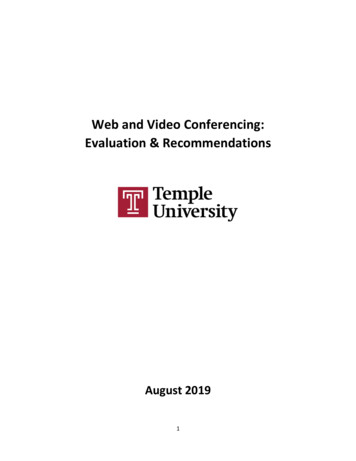
Transcription
Web and Video Conferencing:Evaluation & RecommendationsAugust 20191
Table of ContentsExecutive Summary. 4Section 1: Background/Goals/Scope/Committee/Roadmap . 5Project Background . 5Project Description. 6Project Goals . 7Project Scope . 7Web and Video Conferencing Committee . 8Project Roadmap. 9Section 2: WVC General Pilot Information . 9Faculty Participants . 9Additional Pilot Information . 11Survey Responses . 11Key Survey Items . 12Section 3: Faculty Pilot Survey Information . 12Qualitative Feedback - Faculty . 12Advantages. 14Challenges . 14Section 4: Student Pilot Survey Information. 15Qualitative Feedback - Students . 16Advantages. 17Challenges . 17Section 5: Meeting Pilot Survey Information . 17Qualitative Feedback - Meetings . 18Advantages. 20Challenges . 20Section 6: Zoom Updates and Suggestions for Enhancements . 20Section 7: Impact on Faculty and Training Services . 21Section 8: Administrative (non-Faculty) Setup and Support . 22Section 9: Accessibility and Security . 22Accessibility . 22Security . 22Appendix A – University Feedback. 232
Faculty Open Ended Survey Feedback . 23Student Open Ended Survey Feedback . 25Meeting Pilot Open Ended Survey Feedback . 29General, Unsolicited Email Feedback. 32Appendix B – Survey Detail . 39Student Survey Detail . 39Faculty Survey Detail. 41Meeting Survey Detail9. 44Appendix C – Supported Languages (from the Zoom website) . 46Appendix D – Criteria . 46Appendix E – External Research and References. 51Appendix F – Other Decision Factors . 53Strategic Company Direction . 53Operational Support . 53Other Information. 533
Executive SummaryIn support of identifying and evaluating web and video conferencing (WVC) solutions for virtualmeetings and online learning, a market analysis of the environment was completed in June 2018. In July2018, the Office of the Provost and Information Technology Services (ITS) approved a new WVCcommittee in preparation for the spring 2019 WVC evaluation. Temple deans and administratorsappointed 18 faculty members, staff and student representatives to the committee. Adobe Connect andZoom - two leading WVC solutions were chosen for the pilot(s) and planned for comparison withTemple’s current Cisco WebEx system. Over 40 courses with 600 enrolled students were identified forthe instructional WVC pilot and 100 faculty/staff for the online meeting pilot. At the pilots’ conclusion,the university surveys and supporting feedback would lead to a decision to either renew WebEx byAugust 2020 or move to another prominent WVC system such as Connect or Zoom.In November 2018, prior to the spring semester WVC evaluation, Adobe informed us they decided towithdraw from the pilot program. The company revisited our project criteria and determined thatConnect may not be the best virtual course and meeting solution for Temple. As a result, a universitycommunication was sent to faculty, staff and scheduled pilot participants notifying them of Adobe’sdecision to no longer participate. The WVC committee continued plans for the Zoom pilot and offered allConnect pilot members the opportunity to evaluate Zoom instead. In addition to the university Zoompilots, the College of Public Health ran an independent Zoom evaluation, and the School of PharmacyRegulatory Affairs/Quality Assurance piloted both WebEx and Zoom to compare to Connect (theircurrent application).During the 2019 spring semester, the WVC Committee in collaboration with pilot participants, closelyexamined the features and functionality of Zoom for online instruction and virtual meetings. Thecommittee also compared Zoom and Cisco’s company strategy, commitment to customer service,technical support, marketplace growth, pedagogy and innovation. Key WVC requirements included:room and meeting scheduling, a contemporary user-friendly interface, virtual breakout rooms, webinarsfor controlled one-way meetings, high video and audio quality, mobile applications, lecture and meetingrecordings, accessibility and security. Added features evaluated included: toll calling in the US andinternationally, LMS (Canvas) integration, 24x7 phone, chat and email support, expanded recordingstorage, automated speech recognition (ASR), close captioning, and Zoom rooms for compatibility withPolycom/video conferencing rooms.The survey feedback and supplementary comments from the Zoom pilot participants remained largelypositive. Accordingly, the WVC Committee unanimously recommended the adoption of Zoom as thenew university enterprise solution and replacement for WebEx. The subsequent major findings furthervalidated this decision. Zoom exceeds and supports our educational requirements for online courses and meetingsuniversity-wide. The company offers a progressive technology approach and is well-positioned toadapt to the changing needs of the university in the online learning space.Zoom effectively integrates with our Canvas learning management system (LMS) supportingteaching, student learning and engagement.4
Zoom presents a clean modern interface with intuitive navigation for users across the university.Zoom offers sophisticated features for video and audio, online course and meeting scheduling,unlimited recordings, improved accessibility, and compatibility with other video conferencingsystems.Zoom enriches student collaboration and expands our communication capabilities beyond theclassroom. This is valuable in all teaching contexts and particularly important for growth of onlineprograms.The transition to Zoom should be relatively seamless. The company has agreed to provide Temple witha free year of enterprise use and 24x7 chat/email/phone support while our agreement with WebExcontinues through August 3, 2020. This provides opportunity for early adopters as well as three fullsemesters (fall 2019, spring and summer 2020) to shift from WebEx to Zoom. Also, in preparation forthe transition, training is planned for faculty, staff and students via the Center for the Advancement ofTeaching (CAT), ITS, LinkedIn/Lynda, Temple and Zoom websites and other available resources.Section 1: Background/Goals/Scope/Committee/RoadmapProject BackgroundA university’s web and video conferencing (WVC) system serves an integral role in student-centeredteaching and learning practices. The best WVC system provides an easy, reliable, accessible cloudplatform for video and audio conferencing, collaboration, chat, and webinars across mobile devices,desktops, telephones, and room systems essential for online instruction and virtual communications.With a developing online learning presence at Temple University, the WVC system must support bestpractices to enhance student engagement with instructors and peers, and effectively promote adaptedstudent pathways through the curriculum.At Temple University, WebEx has served as the enterprise WVC platform for more than 10 years.Students, faculty, administrators and staff use WebEx/WVC tools for course delivery, collaboration,assignments, appointments, trainings, meetings/consultations and other commitments. Comparable toany robust technology, the needs and uses for WVC have evolved since the original adoption of WebEx.The upcoming renewal of our WebEx agreement in August 2020 prompted university constituents toevaluate the WVC marketplace and recommend the best WVC platform to support the university’s goalsmoving forward.The university provides thousands of courses in a variety of formats including face-to-face, hybrid,online, etc. via 3,880 faculty members (including 2,296 full-time and 1,554 part-time faculty) toapproximately 40,000 students each semester (including 30,000 undergraduate students and 10,000graduate/professional students). Students, faculty and staff expect a robust and user-friendlyexperience that facilitates communication regardless of the standard. Instructors conduct classes atvarious times and with varying lesson plans. There is no one formula that fits the teaching style, subjectmatter and lesson plan of every faculty. The WVC platform must be flexible enough to fit the needs of allfaculty while at the same time be easy to use for new or inexperienced users. Temple Universitynecessitates a WVC platform that can support existing functions, as well as, adaptably fulfill theUniversity’s ever-advancing needs.5
The university has continually increased its online digital education presence. The online learningdirection in combination with greater numbers of people using the university WVC platform, furthersupports the need to be robust and easy to use. Chart 1 below displays the latest information fordegrees and certificates from Fall 2016
Polycom/video conferencing rooms. The survey feedback and supplementary comments from the Zoom pilot participants remained largely positive. Accordingly, the WVC Committee unanimously recommended the adoption of Zoom as the new university enterprise solution and replacement for WebEx. The subsequent major findings further validated this decision. Zoom exceeds and supports
